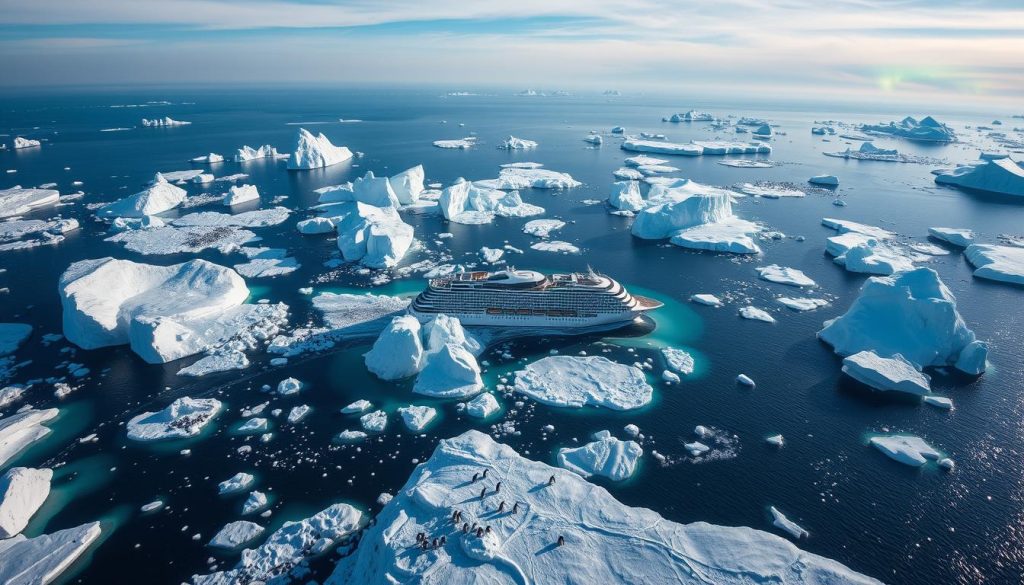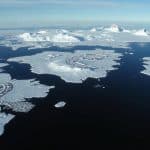Antarctica’s tourism industry is booming, offering many opportunities for businesses. More adventure seekers are looking at this untouched environment. This sparks potential for new business ideas in Antarctica. The International Association of Antarctica Tour Operators notes more visitors want unique travel experiences. They seek adventures that showcase the region’s stunning views and wildlife. This article will discuss opportunities in Antarctic tourism. We’ll look at the industry’s growth, what makes the destinations special, and key success factors.
Understanding the Antarctic Tourism Boom
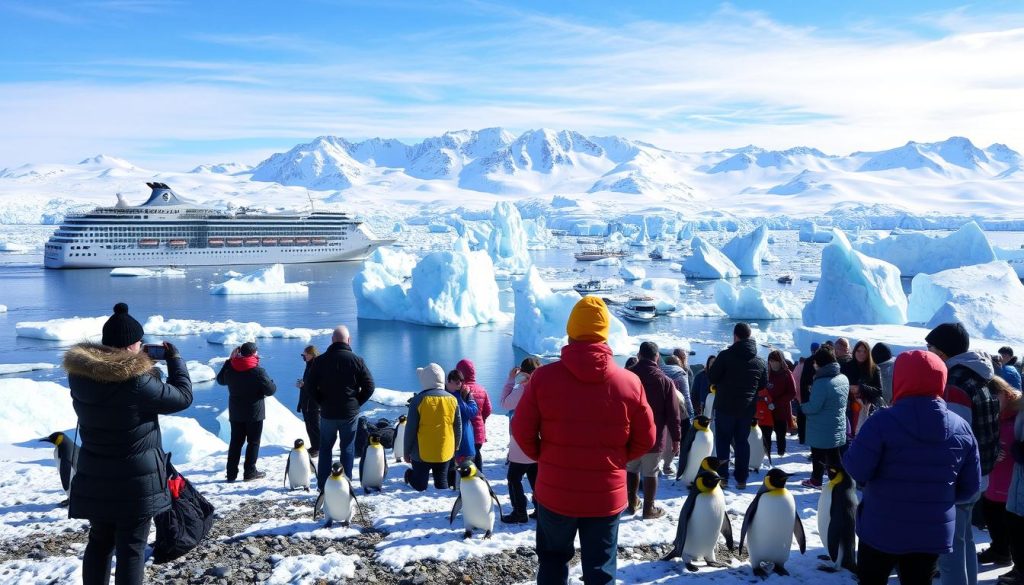
Antarctic tourism has grown a lot, changing how people view far-off places. Now, more travellers than ever want to see its untouched beauty and have unique adventures. There’s a big jump in those looking for something different, choosing to explore places few have seen.
Social media has a big part to play in this. Stunning photos and stories from those who’ve been there spark interest in others. They want to see those amazing places for themselves. This, along with a growing concern for the environment, drives people to connect with nature in Antarctica.
But, this boom in tourists brings up important issues about keeping travel sustainable. As numbers grow, it’s crucial to remember we must travel responsibly. Finding a balance between exploring and protecting such a special place is key.
Unique Characteristics of Antarctic Destinations
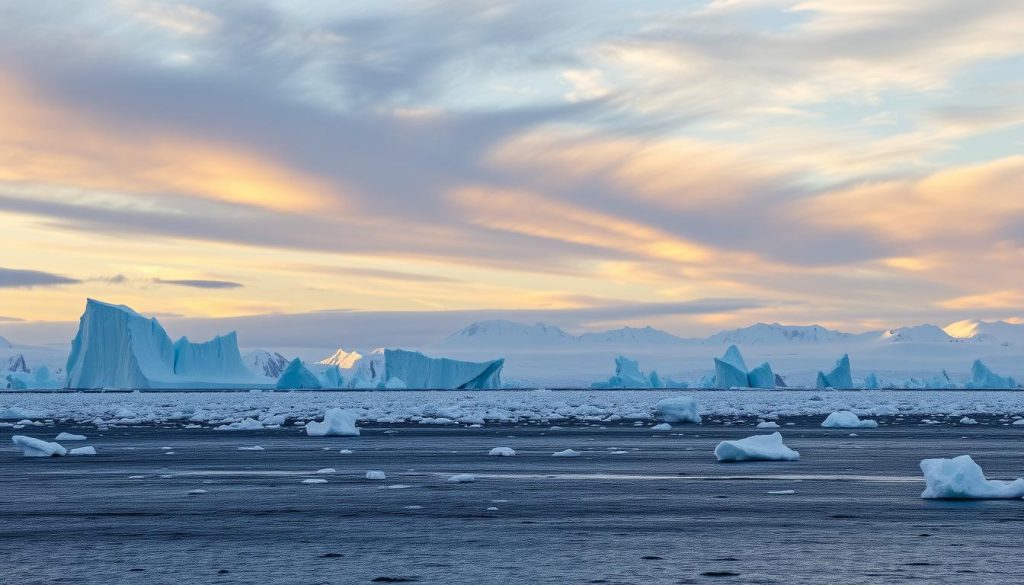
Antarctic landscapes are full of stunning scenes. With tall glaciers and floating icebergs, they offer a unique view. This beauty, mixed with a feeling of being far from everything, attracts many explorers. The place is pure, almost untouched by people.
The variety of life in Antarctica adds to its charm. From different penguins to seals, these animals live in tough conditions. The region is not just beautiful to look at. It also plays a key role in our planet’s ecology. Efforts to protect its rich life are ongoing, thanks to groups like the Antarctic and Southern Ocean Coalition.
Seeing these animals in their home draws many travellers. It might be watching Emperor penguins on the ice or seals enjoying the sun. Being close to such wonders deeply connects us with nature. The mix of amazing views and wildlife makes a trip here unforgettable.
Top tourism-related business opportunities in Antarctica
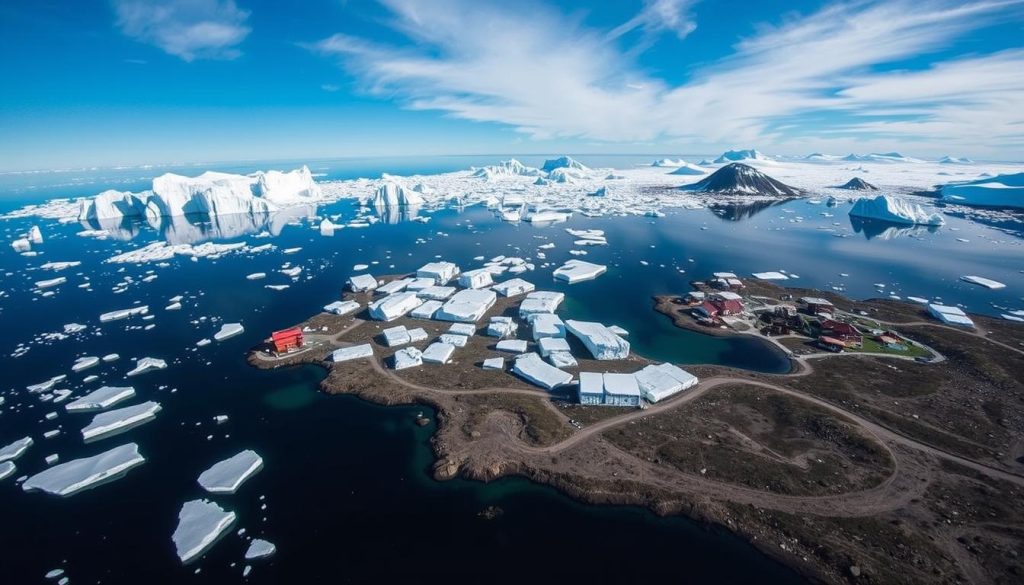
Antarctica is becoming a hot spot for tourists wanting adventure and unique trips. Adventure tourism and cruise tourism are big chances for making money. These areas offer great promise for those looking to invest.
Adventure Tourism: Opportunities for Exciting Experiences
Adventure tourism in Antarctica is on the rise. It offers many activities for those who love excitement and nature. Opportunities include:
- Kayaking expeditions to see wildlife up close.
- Mountaineering trips for breathtaking views.
- Photography tours to capture stunning scenery.
This increase in adventure tourism shows more travellers want to explore untouched places deeply.
Cruise Tourism: Growth and Potential in the Market
Cruise tourism is changing how people visit Antarctica. It’s growing as tourists pick cruises that stop in Antarctica. This growth opens up many business chances, like:
- Starting eco-friendly cruise lines.
- Offering educational tours on board.
- Working with travel agencies for special packages.
Analysis shows more people are choosing cruise tours, making it a key area for tourism businesses in Antarctica.
Eco-Tourism and Sustainability in Antarctica
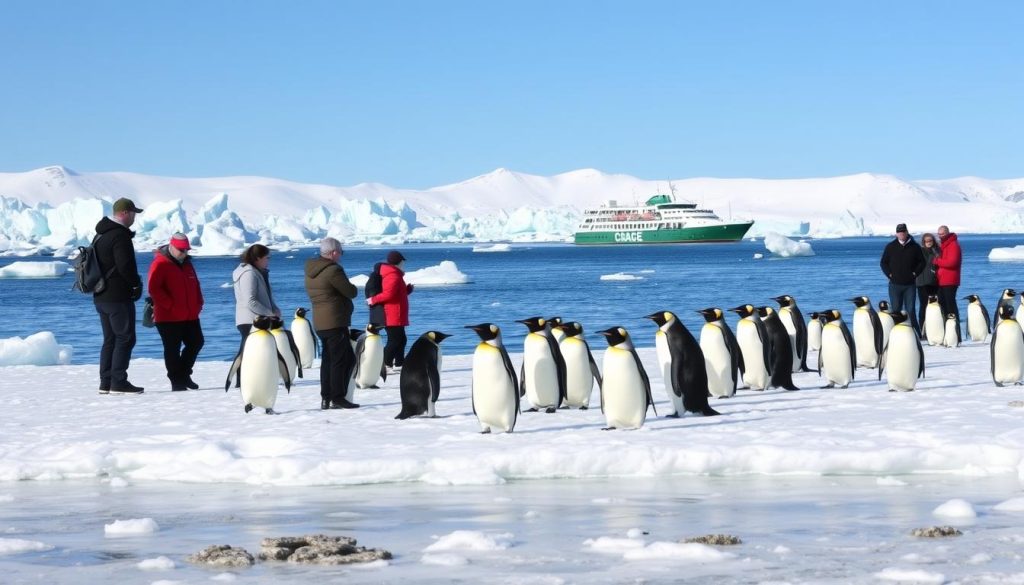
With growing environmental concerns, eco-tourism in Antarctica plays a crucial role in protecting its unique ecosystem. It focuses on responsible travel. Such practices enrich visitors’ experiences while safeguarding the continent’s delicate landscapes and wildlife. Through sustainable travel, tourism supports conservation and the preservation of this extraordinary environment.
Responsible Travel Practices
For tourists eager to explore Antarctica, adopting responsible travel practices is key. This includes:
- Minimising environmental impact by following strict guidelines.
- Promoting awareness and understanding of the local ecosystems.
- Adhering to the International Association of Antarctica Tour Operators (IAATO) rules.
This approach promotes a respect for nature. It encourages tourists to become environmental protectors.
Importance of Conservation Efforts
Tourism conservation is vital for Antarctic ecological balance. Organisations like the Antarctic Conservation Act show how businesses can adopt sustainable operations. These include:
- Backing initiatives that protect native species and their homes.
- Participating in research to better conservation efforts.
- Working with local communities to raise preservation awareness and action.
Such measures protect the area’s bio diversity. They also boost the educational value of visiting Antarctica responsibly.
Regulatory Landscape for Antarctic Tourism Businesses
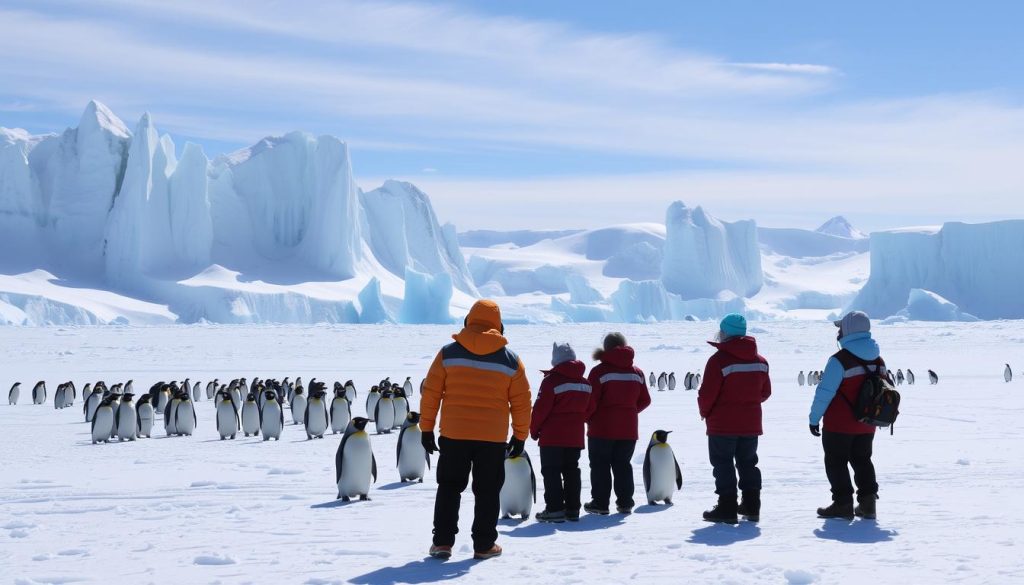
Businesses in Antarctica must follow international rules, mainly the Antarctic Treaty System. This system aims to protect the continent and its wildlife. It focuses on keeping Antarctica’s environment safe while allowing tourism. Companies entering this market must obey these rules.
The International Association of Antarctica Tour Operators (IAATO) is key in overseeing tourism. As a volunteer group, it sets safety and green standards for its members. By following IAATO’s rules, businesses help protect Antarctica’s nature.
There are many rules that companies must follow. They have to get permits and follow environmental guidelines. These steps prevent damage to one of Earth’s untouched places.
For new companies, knowing the laws about Antarctic tourism is vital. They need to understand the details of these laws, which depend on the planned activities. Aligning with these rules, businesses can support ethical tourism.
Popular Activities for Tourists in Antarctica
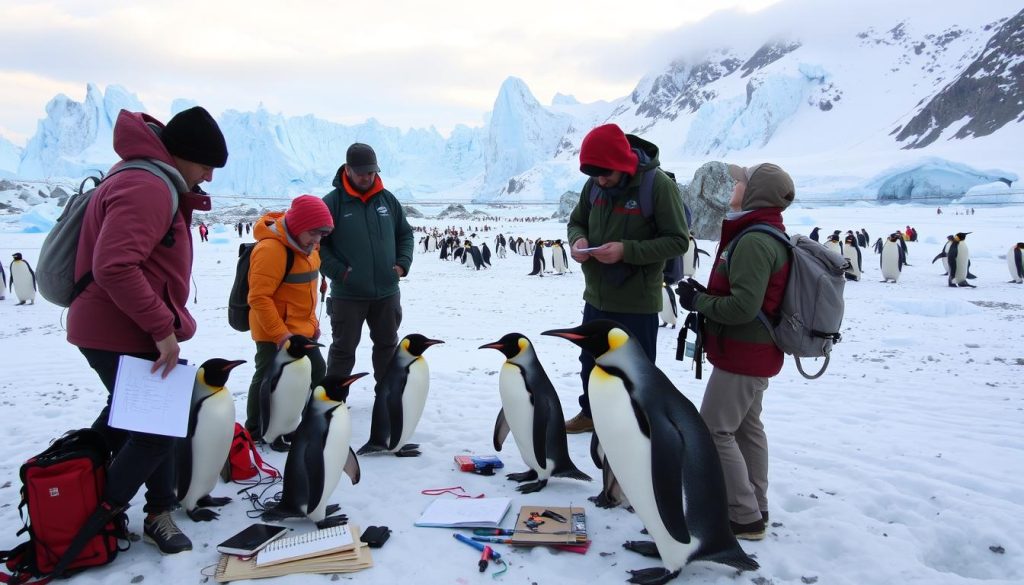
Antarctica is known for its activities that appeal to both thrill-seekers and learners. Visitors get to experience unforgettable moments by engaging with the unique surroundings and creatures. Among these, two main activities are often highlighted for their appeal and importance.
Wildlife Viewing: Understanding Unique Fauna
Tourists can see amazing animals up close in wildlife tours. They watch creatures like penguins, seals, and whales right in their homes. These tours show how these animals live and their role in the ecosystem. Tour operators work with conservation groups to watch wildlife responsibly, protecting these animals.
Scientific Tours: Merging Education with Travel
Scientific tours offer learning and exploration together. They let tourists learn from top researchers on topics like climate change and marine life. These tours help raise awareness about environmental challenges. They also support the businesses offering these insightful experiences.
Technological Innovations Impacting Antarctic Tourism

In recent years, technology has greatly changed Antarctic tourism. It has changed how businesses work and what tourists can do. Now, digital platforms help businesses reach more people who might want to visit.
Virtual reality lets future visitors get a peek of their possible adventures. This makes more people want to visit. Augmented reality adds fun and educational things about the wildlife and history of the places they’ll see.
Better ways of communicating are now key to keeping tourists safe and things running smoothly. Everyone involved can stay in touch easily, making trips better for visitors. Digital tools are especially important in remote areas like Antarctica.
How we get to and stay in Antarctica is becoming more eco-friendly. Companies are using new tech to have less impact on the environment. They are finding ways to use energy better, meeting the demand for green travel.
Partnership Opportunities with Local Businesses
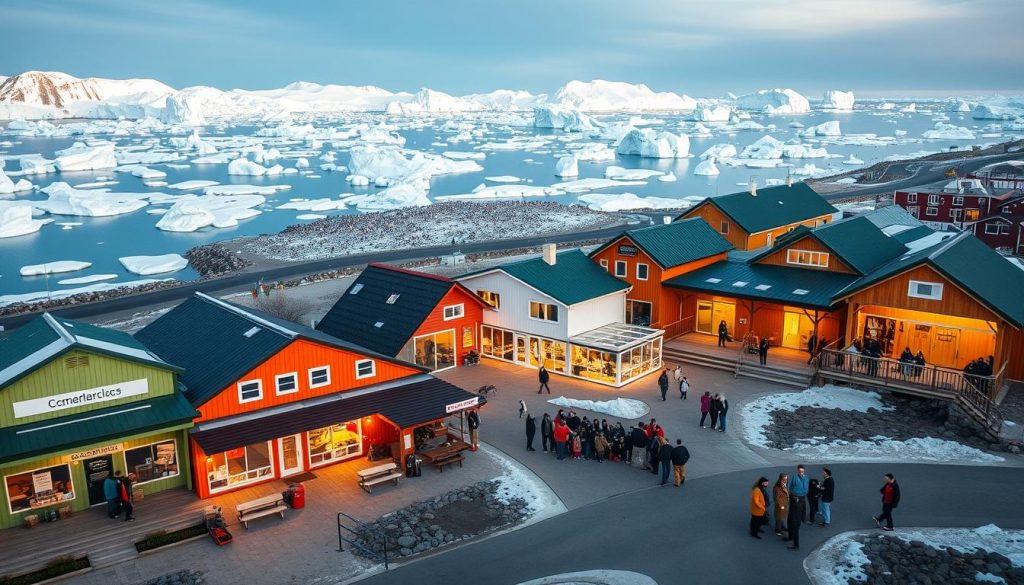
When tourism ventures team up with local businesses, it sparks sustainable growth in Antarctic tourism. These partnerships make the visit more enjoyable and help the local economy. By working together, they gain a deeper understanding of the area’s unique environment and culture.
These partnerships can really benefit both tourists and locals. Involving the community brings out their pride and gets them involved. Some good examples of this include:
- Local shops can sell genuine Antarctic products which enhances the tourism experience.
- Partnering with local guides who know all about the area’s lands and wildlife.
- Supporting eco-friendly projects that encourage sustainable and responsible travel.
It’s key that these projects listen to what the local people want and need. By working together, the Antarctic can continue to grow without losing its natural and cultural treasures.
Challenges Facing Antarctic Tourism Ventures
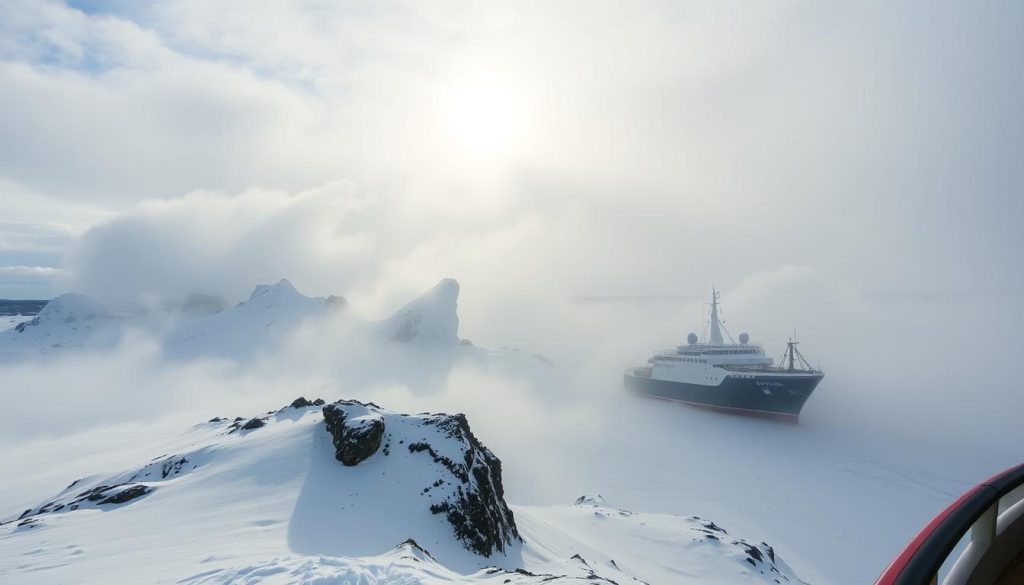
Tourism in Antarctica faces many challenges. The extreme weather and unpredictable climate make it hard for companies. They need careful planning and strong systems to handle these issues. Managing these tough conditions is key to success.
Weather Constraints and Operational Difficulties
The unique weather in Antarctica affects tourism a lot. Operators deal with:
- Unpredictable weather that can cause trips to be cancelled suddenly.
- Seasons that limit when and where travel can happen.
- Logistical problems that need detailed backup plans.
Handling these weather issues requires detailed planning. Companies must be able to change quickly. They adapt to new situations. Success stories show how being flexible and creative is vital in such a changing place.
Marketing Strategies for Antarctic Tourism Businesses
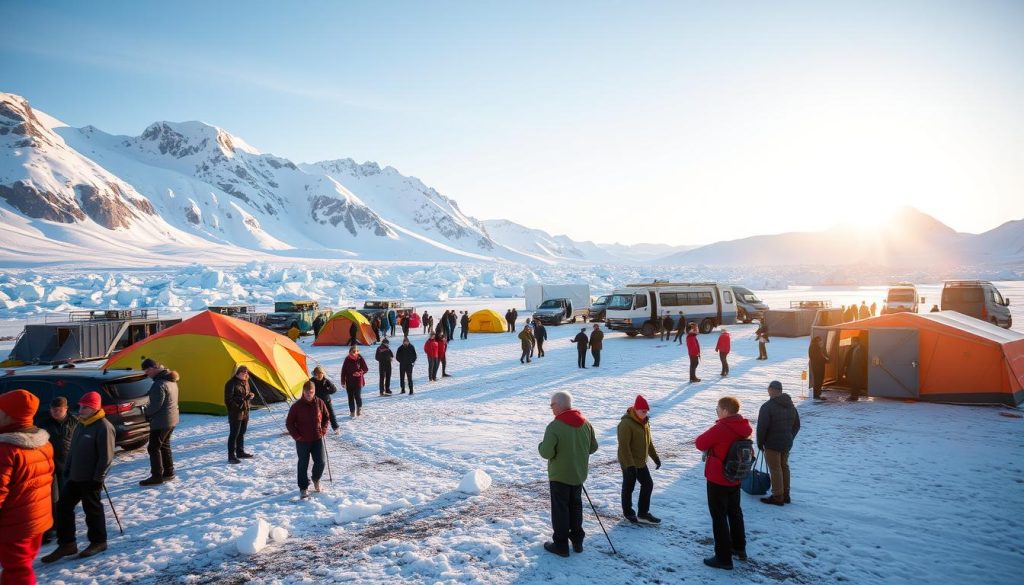
Antarctic tourism is competitive and needs innovative marketing to attract eco-aware travellers. A key part is digital marketing, which boosts tourism by increasing online presence. This helps businesses connect with potential customers effectively.
Visuals greatly impact tourism marketing. Beautiful images and videos of Antarctica’s landscapes can entice adventure-seekers. It showcases the destination’s beauty and conservation efforts, fitting well with brands focused on nature.
Social media is great for targeted marketing. It lets businesses reach out to eco-friendly travel enthusiasts with engaging content. Using interactive polls and sharing user content can build brand loyalty and encourage more visits.
Telling a compelling brand story is crucial. Creating stories that reflect eco-conscious values can improve a brand’s market position. It shows a business’s dedication to sustainability and conservation, marking them as industry leaders.
Case Studies of Successful Antarctic Ventures

Exploring successful Antarctic case studies shows us the key to thriving in this unique market. Companies like Quark Expeditions and G Adventures stand out. They combine innovation and excellent operations.
Quark Expeditions is known for adventure trips. They offer custom tours focused on wildlife and stunning views. This draws travellers who want unique experiences. They use strategies like good customer engagement and eco-friendly practices.
G Adventures opts for small group tours. This approach fosters a closer bond with the environment. They work with local guides, helping communities to benefit from tourism. Their method teaches the value of community and ethical practices.
The cases mentioned teach us important lessons. Knowing your audience and making their experiences unforgettable is key to growth. These stories from Antarctica are rich resources for those starting in tourism. Sustainability and strong relationships make customers come back. Following these best practices increases the chances of success for new market players.
Impact of Climate Change on Antarctic Tourism
Climate change is reshaping Antarctic tourism. Ice shifts, sea levels rise, and wildlife patterns change, posing big challenges. The core appeal of Antarctica lies in its untouched beauty. But, climate effects may harm tourism there. Businesses need to consider their environmental impact and adjust how they operate to stay afloat.
Adapting Business Models to Sustainability Trends
With sustainability worries growing, Antarctic travel companies are moving towards eco-friendly ways. They’re cutting carbon outputs, using green transport, and helping conservation efforts. Meeting the demand for eco-conscious travel can lead businesses to success and protect Antarctica’s delicate nature.
Research points to the need for companies to change their approaches due to climate change. By taking action early, these businesses can be more resilient and help with conservation. They protect their earnings and help keep Antarctica’s wilderness safe for the future.

